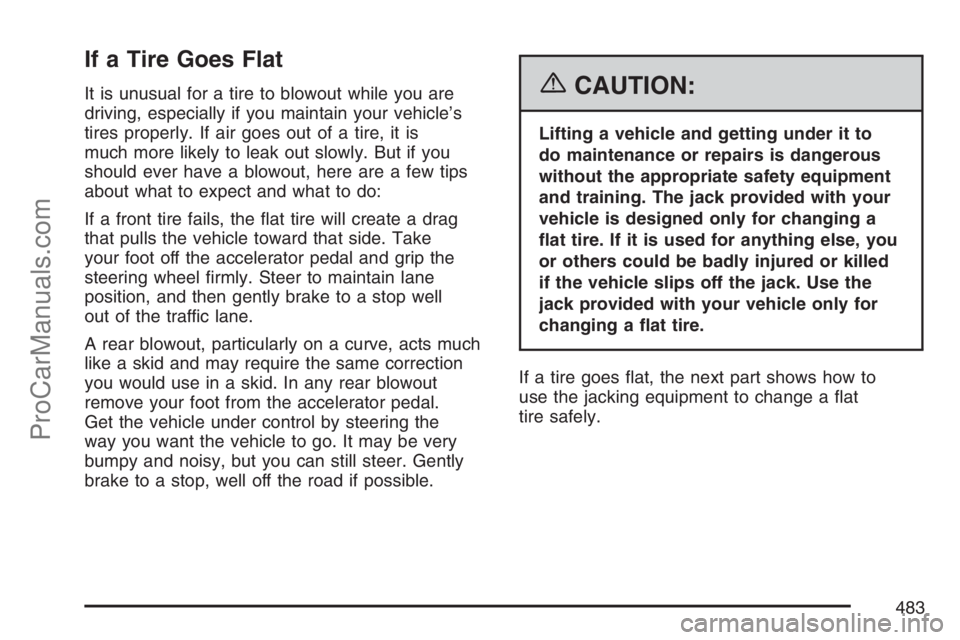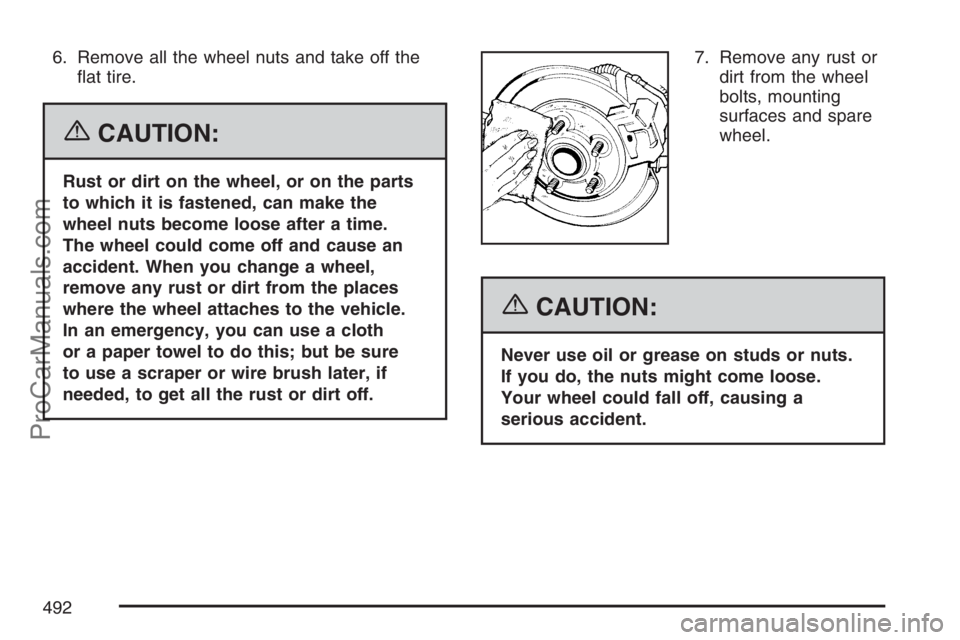change wheel SATURN RELAY 2007 User Guide
[x] Cancel search | Manufacturer: SATURN, Model Year: 2007, Model line: RELAY, Model: SATURN RELAY 2007Pages: 570, PDF Size: 3.41 MB
Page 399 of 570

Your vehicle can tow a trailer. To identify the
trailering capacity of vehicle, you should read
the information in “Weight of the Trailer” that
appears later in this section. Trailering is different
than just driving your vehicle by itself. Trailering
means changes in handling, acceleration, braking,
durability, and fuel economy. Successful, safe
trailering takes correct equipment, and it has to
be used properly.
That is the reason for this section. In it are many
time-tested, important trailering tips and safety
rules. Many of these are important for your safety
and that of your passengers. So please read
this section carefully before you pull a trailer.
Load-pulling components such as the engine,
transaxle, wheel assemblies, and tires are forced
to work harder against the drag of the added
weight. The engine is required to operate
at relatively higher speeds and under greater
loads, generating extra heat. The trailer also adds
considerably to wind resistance, increasing the
pulling requirements.If You Do Decide To Pull A Trailer
If you do, here are some important points:
There are many different laws, including speed
limit restrictions, having to do with trailering.
Make sure your rig will be legal, not only
where you live but also where you’ll be driving.
A good source for this information can be
state or provincial police.
Consider using a sway control. See “Hitches”
later in this section.
Do not tow a trailer at all during the �rst
500 miles (800 km) your new vehicle is driven.
Your engine, axle, or other parts could be
damaged.
During the �rst 500 miles (800 km) that you
tow a trailer, do not drive over 50 mph
(80 km/h) and do not make starts at full
throttle. This helps your engine and other parts
of your vehicle wear in at the heavier loads.
You can use THIRD (3) or, as you need to, a
lower gear when towing a trailer. Operating
your vehicle in THIRD (3) when towing a trailer
will minimize heat buildup and extend the
life of your transaxle.
399
ProCarManuals.com
Page 406 of 570

Backing Up
Hold the bottom of the steering wheel with
one hand. Then, to move the trailer to the left,
just move that hand to the left. To move the trailer
to the right, move your hand to the right. Always
back up slowly and, if possible, have someone
guide you.
Making Turns
Notice:Making very sharp turns while
trailering could cause the trailer to come in
contact with the vehicle. Your vehicle could
be damaged. Avoid making very sharp
turns while trailering.
When you are turning with a trailer, make wider
turns than normal. Do this so your trailer will
not strike soft shoulders, curbs, road signs,
trees, or other objects. Avoid jerky or sudden
maneuvers. Signal well in advance.
Turn Signals When Towing a Trailer
When you tow a trailer, your vehicle has to have
extra wiring.
The arrows on your instrument panel will �ash
whenever you signal a turn or lane change.
Properly hooked up, the trailer lamps will also
�ash, telling other drivers you are about to turn,
change lanes, or stop.
When towing a trailer, the arrows on your
instrument panel will �ash for turns even if the bulbs
on the trailer are burned out. Thus, you may think
drivers behind you are seeing your signal when
they are not. It is important to check occasionally to
be sure the trailer bulbs are still working.
406
ProCarManuals.com
Page 448 of 570

Properly torqued wheel nuts are necessary to help
prevent brake pulsation. When tires are rotated,
inspect brake pads for wear and evenly tighten
wheel nuts in the proper sequence to Saturn
torque speci�cations.
Brake linings should always be replaced as
complete axle sets.
Brake Pedal Travel
See your retailer if the brake pedal does not return
to normal height, or if there is a rapid increase
in pedal travel. This could be a sign of brake
trouble.
Brake Adjustment
Every time you apply the brakes, with or without
the vehicle moving, your brakes adjust for wear.
Replacing Brake System Parts
The braking system on a vehicle is complex.
Its many parts have to be of top quality and
work well together if the vehicle is to have
really good braking. Your vehicle was designed
and tested with top-quality Saturn brake parts.
When you replace parts of your braking
system — for example, when your brake
linings wear down and you need new ones
put in — be sure you get new approved Saturn
replacement parts. If you do not, your brakes
may no longer work properly. For example,
if someone puts in brake linings that are wrong
for your vehicle, the balance between your
front and rear brakes can change — for the worse.
The braking performance you have come to
expect can change in many other ways if someone
puts in the wrong replacement brake parts.
448
ProCarManuals.com
Page 473 of 570

{CAUTION:
Rust or dirt on a wheel, or on the parts to
which it is fastened, can make wheel nuts
become loose after a time. The wheel
could come off and cause an accident.
When you change a wheel, remove any
rust or dirt from places where the wheel
attaches to the vehicle. In an emergency,
you can use a cloth or a paper towel to
do this; but be sure to use a scraper or
wire brush later, if needed, to get all the
rust or dirt off. SeeChanging a Flat Tire
on page 484.
When It Is Time for New Tires
One way to tell when it
is time for new tires is
to check the treadwear
indicators, which will
appear when your tires
have only 1/16 inch
(1.6 mm) or less of tread
remaining.
You need a new tire if any of the following
statements are true:
You can see the indicators at three or more
places around the tire.
You can see cord or fabric showing through
the tire’s rubber.
The tread or sidewall is cracked, cut, or
snagged deep enough to show cord or fabric.
The tire has a bump, bulge, or split.
The tire has a puncture, cut, or other damage
that cannot be repaired well because of the
size or location of the damage.
473
ProCarManuals.com
Page 483 of 570

If a Tire Goes Flat
It is unusual for a tire to blowout while you are
driving, especially if you maintain your vehicle’s
tires properly. If air goes out of a tire, it is
much more likely to leak out slowly. But if you
should ever have a blowout, here are a few tips
about what to expect and what to do:
If a front tire fails, the �at tire will create a drag
that pulls the vehicle toward that side. Take
your foot off the accelerator pedal and grip the
steering wheel �rmly. Steer to maintain lane
position, and then gently brake to a stop well
out of the traffic lane.
A rear blowout, particularly on a curve, acts much
like a skid and may require the same correction
you would use in a skid. In any rear blowout
remove your foot from the accelerator pedal.
Get the vehicle under control by steering the
way you want the vehicle to go. It may be very
bumpy and noisy, but you can still steer. Gently
brake to a stop, well off the road if possible.{CAUTION:
Lifting a vehicle and getting under it to
do maintenance or repairs is dangerous
without the appropriate safety equipment
and training. The jack provided with your
vehicle is designed only for changing a
�at tire. If it is used for anything else, you
or others could be badly injured or killed
if the vehicle slips off the jack. Use the
jack provided with your vehicle only for
changing a �at tire.
If a tire goes �at, the next part shows how to
use the jacking equipment to change a �at
tire safely.
483
ProCarManuals.com
Page 484 of 570

Changing a Flat Tire
If a tire goes �at, avoid further tire and wheel
damage by driving slowly to a level place.
Turn on your vehicle’s hazard warning �ashers.
SeeHazard Warning Flashers on page 182
for more information.{CAUTION:
Changing a tire can be dangerous. The
vehicle can slip off the jack and roll over
or fall on you or other people. You and
they could be badly injured or even killed.
Find a level place to change your tire.
To help prevent the vehicle from moving:
1. Set the parking brake �rmly.
2. Put the shift lever in PARK (P).
3. Turn off the engine and do not restart
while the vehicle is raised.
4. Do not allow passengers to remain
in the vehicle.
To be even more certain the vehicle will
not move, you should put blocks at the
front and rear of the tire farthest away
from the one being changed. That would
be the tire, on the other side, at the
opposite end of the vehicle.
484
ProCarManuals.com
Page 485 of 570

When your vehicle has a �at tire, use the following
example as a guide to assist you in the placement
of wheel blocks.
The following information will tell you next how to
use the jack and change a tire.Removing the Spare Tire and Tools
The tools needed to remove the spare tire are
located in the storage compartment at the rear of
the vehicle, on the passenger’s side.
To remove the tools, do the following:
1. Open the liftgate. SeeLiftgate on page 128
for more information.
2. Remove the convenience net, if the vehicle
has one.
485
ProCarManuals.com
Page 492 of 570

6. Remove all the wheel nuts and take off the
�at tire.
{CAUTION:
Rust or dirt on the wheel, or on the parts
to which it is fastened, can make the
wheel nuts become loose after a time.
The wheel could come off and cause an
accident. When you change a wheel,
remove any rust or dirt from the places
where the wheel attaches to the vehicle.
In an emergency, you can use a cloth
or a paper towel to do this; but be sure
to use a scraper or wire brush later, if
needed, to get all the rust or dirt off.7. Remove any rust or
dirt from the wheel
bolts, mounting
surfaces and spare
wheel.
{CAUTION:
Never use oil or grease on studs or nuts.
If you do, the nuts might come loose.
Your wheel could fall off, causing a
serious accident.
492
ProCarManuals.com
Page 567 of 570

Safety Belts (cont.)
Safety Belts Are for Everyone.................... 32
Shoulder Belt Height Adjuster.................... 47
Safety Warnings and Symbols......................... 4
Scheduled Maintenance............................... 522
Seats
Bucket Seats, Rear.................................... 14
Captain Chairs........................................... 22
Head Restraints......................................... 13
Heated Seats............................................. 10
Manual........................................................ 9
Power Seats.............................................. 10
Rear Seat Operation.................................. 14
Reclining Seatbacks................................... 11
Third Row Seat......................................... 27
Second Row Center Console...................... 171
Secondary Latch System............................. 495
Securing a Child Restraint
Rear Seat Position..................................... 77
Right Front Seat Position........................... 79
Security Light.............................................. 232
Service........................................................ 412
Accessories and Modi�cations.................. 412
Adding Equipment to the Outside of
Your Vehicle......................................... 414
California Proposition 65 Warning............. 413Service (cont.)
Doing Your Own Work............................. 413
Engine Soon Light................................... 229
Publications Ordering Information............. 553
Servicing Your Airbag-Equipped Vehicle......... 99
Setting the Time.......................................... 272
Sheet Metal Damage................................... 508
Shifting Into Park (P)................................... 148
Shifting Out of Park (P)............................... 149
Shoulder Belt Height Adjuster........................ 47
Signals, Turn and Lane-Change.................. 184
Sliding Door, Power..................................... 121
Sliding Doors, Dual..................................... 118
Spare Tire
Accessory In�ator..................................... 480
Compact.................................................. 500
Installing.................................................. 488
Removing................................................ 485
Storing..................................................... 497
Speci�cations, Capacities............................ 518
Speedometer............................................... 221
StabiliTrak
®System..................................... 367
Starting Your Engine................................... 140
Steering...................................................... 369
Steering Wheel Controls, Audio................... 353
Steering Wheel, Tilt Wheel.......................... 182
567
ProCarManuals.com